

 The South African
The South African
* Geoffrey Mangin was an SSS radar maintenance technician attached to the SAAF during the Second World War (1939-J945) and is now involved in a radar information service from Cape Town. Sheilah Lloyd, also in Cape Town, was an SSS coastal radar operator.
Today most people in South Africa know something about radar and that it played a vital role during the Second World War, particularly during the Battle of Britain. In this age of television, cell phones, computers, E-mail, electronic banking and the Internet, radar is generally taken for granted as an important tool for the navigation of aircraft and ships, as well as for use in weather forecasting and in military hardware. However, few know how, in the Second World War, South Africa developed its own radar which protected the vulnerable coastal shipping route and proved invaluable in helping the Air Force and other branches of the Union Defence Forces (UDF) in carrying out their operations. The reason for this is that it was kept so secret that hardly any members of the armed forces had any idea that it was being used. Minimal records were kept and most war historians found no information about it.
In September 1939, General J C Smuts had become the new prime minister and the commander of the military forces of a country deeply divided politically and totally unprepared for war. Britain had already asked the member countries of its Commonwealth to co-operate in the use of 'certain technical developments ... of vital importance against air attack'. This was a reference to the use of new secret radar as a defensive weapon. Britain, Germany, Russia, Japan and the United States of America had known something about radar for some years, but it was kept a closely guarded secret by each country and none knew precisely the extent to which the others had developed its use.
Radar (radio detection and ranging) involves beaming brief, powerful radio pulses in a specific direction. Upon striking an object, these pulses are reflected back to register as 'echoes' or 'blips' on a television-type screen. The time taken for the radio pulses to return indicates the distance of the object.
Early in September 1939 General Smuts approached Dr Basil Schonland FRS, Director of the Bernard Price Institute for Geophysical Research at Wits University (BPI),to prepare for the use of radar. Dr Schonland was a leading radio propagation authority with experience dating back to the First World War (1914-18). He was asked to meet the Winchester Castle in Cape Town and confer on board with a Dr F M Marsden. An eminent New Zealand physicist, well-known to Schonland, Marsden was on his way home after attending a secret briefing in England on the development and use of radar in wartime. On 14 September Schonland boarded the ship and travelled with Marsden to Durban, learning all the latest British information. In Durban, Schonland borrowed Marsden's copy of a British RDF manual and had it secretly copied at the University of Natal. (RDF, an abbreviation for 'radio direction finding', was the original code name given to the secret system).
Also amongst Marsden's belongings on board the Winchester Castle were various bits and pieces of radar equipment, sealed in a spare mail room, as well as a secret package of unknown contents which was entrusted to the Captain with orders that he should throw it overboard if his ship was stopped.
Essentially, South Africa had assumed responsibility for protecting the vulnerable sea route around the Cape, which was a vital lifeline for the Allied forces and an important communications link between East and West. Britain promised to send radar equipment when it became available, which South Africa would then operate. Schonland returned to the BPI and assembled a small team of scientists: G R Bozzoli from the University of the Witwatersrand, W F Phillips from the University of Natal, N H Roberts from the University of Cape Town and P G Gane from BPI. In 1940, a very young F J Hewitt from Rhodes University, J H Browne from UCT and David Hodges from the University of Natal, were added to the team. Their immediate task was to construct a radar system suitable for training in preparation for the arrival of the British equipment.
Secrecy was very important, especially as a large part of the South African population was sympathetic towards Nazi Germany. The team had to find suitable components in local amateur radio supply shops, and, with the aid of the copy of the RDF Manual and the Radio Amateur's Handbook, they managed, in a couple of months and with much ingenuity, to complete an effective radar transmitting/receiving apparatus. They christened it the 'JB' (for 'Johannesburg').
By December 1939, in an endeavour to receive reflected 'echoes' from an aircraft, the Air Force was asked to fly an aeroplane on a particular course at a fixed time. Nothing, however, appeared on the screen, since the pilot - who of course had no idea as to the reason for his instructions - had diverted from course in order to wave to his girlfriend in her garden in Roodepoort!(1) Finally, in great secrecy on 16 December 1939 ('Dingaan's Day', as that public holiday was then known) the team obtained their first weak echo from Northcliff, at a distance of about 8 km away, in a moment of private jubilation. After various modifications and adjustments, the JB recorded readings from the Magaliesberg some 100 km to the north and later it picked up aircraft at 60 km. South Africa's radar was operational.
The laboratory prototype used the highest possible radio frequency achievable by the available valves - 90 MHz (wavelength 3,3 m) with a peak power output of about 5 kW. The expected British COL (Chain Overseas Low) radars, would probably produce about 100 kW at 200 MHz (1,5 m).
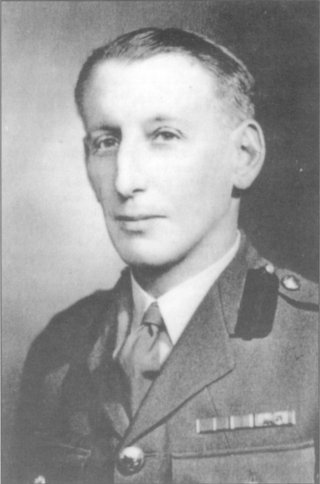
Dr B F J Schonland, the father of South African radar
When Italian forces started their advance in East Africa, the 1st South African Division was sent to confront them and, as air raids on the Allied headquarters at Nairobi were anticipated, the military command felt that radar could supply suitable advance warning. Members of the BPI research team under Schonland took a JB radar unit to Mambrui, about 160 km north of Mombasa, and had it operating by 1 August 1940. Having the designers of the set on the spot meant that various odd problems could be solved and ad hoc improvements could be made. The radar unit was protected by the 1st South African Anti-Aircraft Brigade. Later, an additional four BPI-built JBs were set up near Mombasa and Nairobi.
The various deployment movements involved seemed to have been continually dogged by mix-ups due to the enforced secrecy. In his book, South African Radar in World War II, Peter Brain recounts that when an RAF officer arrived at Mombasa to decide on a site for a British radar station, he was unaware that a South African station was already in operation there!(1) As he was not allowed to inform the South African commanders of his reason for being there, communication became somewhat difficult! Finally the commander of the AA Brigade told him that 'if by any chance he was thinking of putting up a radar station he ought to know that there was one already'.
The British were impressed with the South African apparatus and, after the defeat of the Italians, they asked for the JBs to be relocated in order to support RAF installations covering the Suez Canal. The sets were then installed at El Arish, Rafah and El Midan in the Sinai coastal area in mid-1941, still under the supervision of BPI research personnel. The home-made JBs were tracking hostile bombers at 120 km, frequently achieving better results than the adjacent huge, factory-built British MRUs which operated on the longer wavelength of eight metres, not ideal for the local situation.
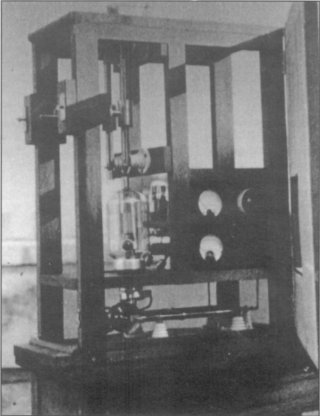
One of the first Johannesburg 'JB' radar transmitters
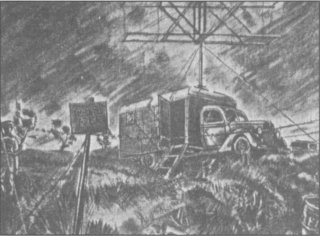
A drawing, by Geoffrey Long, of South Africa's first coastal
radar station - a JB on Signal Hill (Source: The original
drawing is at the SA National Museum of Military History, Johannesburg)
By this time Dr Schonland, then a lieutenant-colonel, had been claimed by the United Kingdom, where his exceptional skills were needed. He was appointed Superintendent of the Operational Research Group within the Air Defence Research and Development Establishment (ADRDE). Shortly afterwards, he was promoted to the rank of brigadier and became largely responsible for much of the Allied radar planning.
In August 1942, the SSS personnel were withdrawn from the Middle East for coastal defence duties back at home and the JBs in Sinai were taken over by the Royal Air Force. By then, enemy surface raiders, minelayers and submarines, possibly supplemented by Japanese craft, were becoming an increasing menace off the South African coast where there was an escalation in shipping activity. Upon his return from the Middle East, Lt Col David Hodges took over command of the SSS. There was still no sign of the promised British radar sets. The programme of design and production of JBs had been stepped up under Maj Bozzoli and an improved set operated at the more effective, slightly higher frequency of 120 MHz, with a single aerial being shared between the transmitter and receiver. The mobile concept was abandoned. From 1942 onwards, as planned by Col Collins and the military chiefs, twelve of these radar sets were erected in the vicinity of Cape Town, Port Elizabeth, East London and Durban. These UDES (Union Defence Experimental Stations) operated continuously with complements of about ten operators and four technicians, most of whom had just completed their training at special radar schools in Johannesburg, Cape Town and Durban. As early as 15 June 1940, 390 ships were reported to be active in the area, but by 1942, with the Suez Canal closed, their numbers had increased enormously.
With the station operating 24 hours a day, the JB operator on shift was required to turn a handle to rotate the aerial whilst watching for reflected echoes ('blips') on the cathode ray tube, on which the distance was indicated. The bearing of the aerial was read from an engraved metal scale. The operator would then send this information by telephone or radio to a central SSS 'Filter Room' (or 'Freddie') for all stations in the region, stating whether it appeared to be a ship, fishing boat or aircraft or a U-boat. Much depended on the experience of the operator, but it was quite easy to identify a submarine which suddenly surfaced. The plot would be placed on a end on the table in the filter room and subsequent readings would be taken on the object at short intervals so that a track developed. Other stations might be reading the same object, and 'Freddie' would filter the plots to get as accurate a track as possible. This information would then be conveyed to an adjacent Combined Operations Unit (representing the Army, Navy and Air Force) and, when it was considered necessary, Ops would send an aeroplane or patrol boat to investigate the source of unusual echoes.
In the early days of South African coastal radar, even the people in Combined Ops had little idea of how radar operated because of the cloak of secrecy which surrounded it. Sometimes Ops adopted the attitude that 'there can't be anything there because we haven't got anything there'. It was only much later that the secrecy was relaxed sufficiently to allow some of the senior Ops personnel to visit the filter rooms and radar stations. Until then, incidents of non-cooperation were frequent and quite serious. Ops were also handicapped because the few available SAAF aircraft (mainly Ansons and Junkers) had limited ranges and could rarely carry bombs or depth charges, but these were upgraded over the years. Bad weather around the Cape was notorious. Lighthouses were not functioning coutinuously, and there was a 'radio silence', all factors which could lead to aeroplanes getting lost. Some ships' navigators might also not have had the appropriate maps.
But help was at hand. By late 1942, with shipping losses on the increase, some of the promised Allied radar equipment finally began to arrive. One of the great wartime secrets, the revolutionary cavity magnetron, was at the heart of two new 10 cm CD (coastal defence) radars in octagonal wooden structures which had been obtained with Schonland's influence. These were Type NT 273-S and had been made for the Royal Navy. Their small parabolic aerials projected a very narrow radar beam which was ideal for detecting U-boat conning towers and sometimes even their periscopes. One of these sets was erected on Signal Hill and the other one at Cape Point. (It is interesting to note that, today, almost every home has one of these secret magnetrons - inside the microwave oven!)
As from 1943 the first of the seventeen long-awaited COL radars began to arrive. They had been specially adapted for tropical conditions and operated at 200 MHz with a four-tier horizontal dipole aerial. The map-like television-type display was called the 'plan position indicator' or PPI. The COL was ideal for tracking shipping and low-flying aircraft. Most of the JBs around the coast were gradually replaced. However, some of the original radars continued to send in excellent readings throughout the war, thanks especially to the skills of the dedicated operators involved. Generally, however, the enemy craft seemed to suspect that South Africa had its own coastal radar and tended to keep quite far out at sea.
Initially, the coastal radar stations were all operated by men, but this could not be continued as all able-bodied men were needed for active service 'up north". Thus the decision was taken late in 1941 (especially after Bozzoli's experiences on Signal Hill) to train university-educated women as radar operators.
The experiences of a radar operator in South Africa
The recruitment of radar operators was not an easy task because of the need for secrecy. Recruitment officers could not be told what the girls would be doing and were informed simply that a new secret unit attached to the Signal Corps needed women recruits with a university degree or other higher education qualification, and they were asked to refer likely candidates to the SSS recruiting officer. Some recruitment also took place at the universities. While little detail could be given to potential recruits, the requirement that they take an oath of secrecy intrigued them greatly.
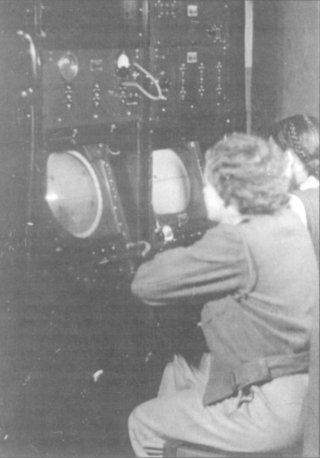
Operators read the screens of a COL radar.
The next day, the recruits, self-conscious in their uniforms, emerged from the Club and were confronted with the requirement (drummed into them at the Club) to salute any officer they encountered. Since they had not yet been taught how to salute, some very funny efforts ensued - and Johannesburg was swarming with army and air force officers.
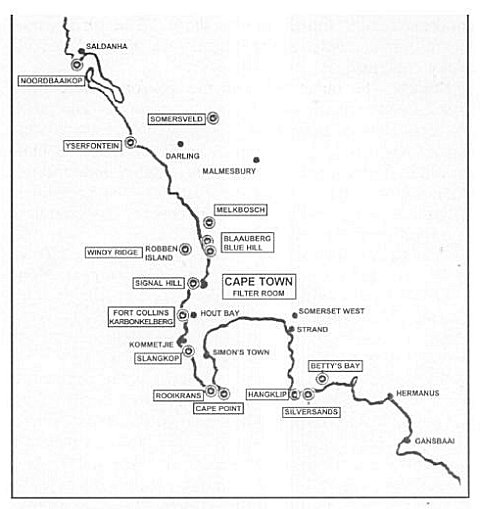
A map of radar stations in the Western Cape
during the Second World War
Much discussion took place as to whether it was better to be posted to a station or to 'Freddie' - not that they were given a choice! Those working in 'Freddie' had an overall picture of what was happening throughout the region, whilst those at a station knew only what was showing up on their own screen. 'Freddie' girls, by working fairly closely with Combined Ops, were often privy to secret information about ship sinkings and tonnages, the detection of U-boats, aircraft losses, etc. Such information, being totally secret, only reached the stations long afterwards, if ever. 'Freddie' girls also had all the city amenities to draw upon during their hours of leave, whilst station operators usually lived at isolated outposts in an unspoiled environment, with sea and empty beaches on their doorstep.
Sheilah Lloyd was always a 'station girl' and her favourite was Silversands at Cape Hangklip. To reach it, she had to travel by train to Somerset West and climb into the back of the 'ration van' (which collected supplies every few days and was the station's link with civilization) and set off along the coast road. At Steenbras Bridge, which was securely guarded, military passes were checked and from there on, the van drove on an untarred road for some 40 km through unspoiled wilderness. On one side was the mountain and flowering fynbos; on the other the sea. A strong clean wind blew the scents of sea and mountain around those at the station - and there was never another human habitation in sight.
On arrival at camp the girls were met by the station commander and with him, the OC Women, who was not much older than the girls in her charge. They were taken to their quarters - which were shielded by a standard split pole fence - dubbed the 'chastity fence'!
A little distance from the camp and clinging precariously to the mountain side was a small hut. This was the original Hangklip Radar Station with an old but effective JB set which was manned mainly by veterans of the desert war, who initially only had radio contact with the outside world. These men shared the simple recreation and eating quarters with the women and were billeted nearby. Silversands Station, with its complement of about twenty, was equipped with a very new British COL and was a little way down the coast from the camp. The girls could and, on occasion, did walk to and from shifts, but more usually drove in one of the army vehicles - especially at night and in poor weather.

Plotting tracks in the Cape Town Filter Room
The nearest thing to civilization for those at Silversands was Sandown Bay (now known as Kleinmond). Situated at the mouth of the lovely Palmiet River quite some distance away, it boasted a typical old-fashioned South African hotel, a few houses, a general dealer-cum-bottle-store and a manual petrol pump. The garbage from the camp had to be taken to Sandown Bay once or twice a week for disposal and the girls, if not on shift, were allowed to go along for the ride. In the 'ladies lounge' of the Sandown Hotel they were served the beverage of their choice. Port and lemon, Sheilah recalls, was a favourite, and reasonably daring, whilst ginger squares (ginger brandy and ginger ale) were also popular. Very occasionally there would be a dance at the hotel on a Saturday night, well attended by the local community from far and wide - and every now and again the girls were permitted to join them. Those were the dancing years and long dresses were the essential wear and the radar girls usually wore greatcoats over them as it was pretty chilly huddling in the back of the ration van, especially during a cold wet winter. By midnight they had to be back in camp and safe behind their chastity fence. Those who were unfortunately due on the 03h00 shift, would then try to snatch a short nap.
Generally, however, the leisure hours were spent on the lovely beaches and rocks below the camp Bathing was delightful, fishing off the rocks popular, and a lot of crayfish caught by the men. A 21st birthday party was once celebrated with a braaivleis on the beach beneath a full moon - an unforgettable occasion for those not on shift. The radar operators also enjoyed walking on the mountain slopes below the Hangklip overhang. A close watch had to be kept for snakes which were plentiful in the summertime.
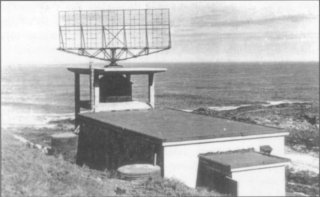
The Yserfontein COL radar station, Western Cape
Off-duty, the radar unit and the air force were often royally entertained by the local farmers and their families. There was horse riding on offer; there were braais and Sunday dinners, such as were seldom experienced during the war. The hospitality and kindness extended by the locals - whatever their political affiliations - was wonderful. Of course, the operators never spoke about their work.
On pass, it took about 3¼ hours to get to Cape Town from Darling by train. The steam train chugged along through the veld and there was nothing much in sight for miles until it reached a siding called Kalabaskraal. Here, while the puffing engine had its water tanks filled up, almost everyone left the train and streamed across the tracks to a nearby lone hotel. As soon as the engine had been refuelled, the driver gave three short blasts on his whistle and the dozens of sailors from Saldanha, airmen and a few SSS girls from Darling would down their last mouthfuls and jog back to the train. Inevitably there were always a few stragglers, usually sailors who, joyful at having escaped the Navy for a short time, lingered too long in the pub and had to run after the train. The driver was always tolerant and chugged along very slowly until the last lingerer was dragged safely aboard.
Meanwhile, radar detection activities continued. While much of the work on the stations was routine, there were exciting times on most stations. On one occasion, a huge liner in heavy fog and laden with troops was being tracked by radar when, at the last moment, she had to be warned off by rifle fire from crashing into Robben Island! Because of the enforced wireless silence, this type of warning was sometimes necessary in the case of other ships about to go aground - including one carrying ammunition which, had it foundered and exploded, might have wiped out a large part of Sea Point.
Some operators, including those stationed at Signal Hill and at Cape Agulhas, were sometimes convinced that they had plotted German U-boats at night, but Combined Ops were unable to do anything because suitable attack vessels or aircraft were simply not available. It is believed that some mysterious Allied sinkings which occurred over a couple of weeks not far from Cape Point, were caused by a German U-boat which was being replenished just outside Hout Bay by a dilapidated 'tramp', supposedly awaiting repairs, which was actually an 'enemy mother ship'.
There was also an incident off the Natal coast one night when a small echo, following an erratic course, was reported. Ops initially showed no interest, having decided that the radar operators were probably reading on a shoal of fish or a whale, which was known to happen. Finally, however, Ops became worried by the persistent and insistent readings and sent a vessel to investigate. The echo proved to be caused by a lifeboat with a few desperate survivors from a ship, out of radar range, which had been torpedoed during the night.
Peter Brain also recounts in his book how, in the early hours of the morning of 1 April 1944, an operator at Slangkop on the west coast of the peninsula reported to 'Freddie' an intermittent echo which he considered to be a submarine as it produced an odd-looking track. Ops refused to accept this and told 'Freddie' at 07.15 that it was probably a fishing boat with a low freeboard and that they could remove the track from the table. At 12.03 the British-registered 5 277 ton Danomian was torpedoed just off Cape Point and 'in no time the Freddie table was covered with an inextricable tangle of tracks as everything that could float or fly streamed down to the Point to look for the U-boat'. Cape Command never managed to locate the U-boat, but months later it was found off Dakar, when it was forced to surface after an air attack and was unable to dispose of its papers because of the presence of a British vessel. The log showed that, on the day concerned, it had charged its batteries off Slangkop until 06.00 and had then torpedoed a freighter at 12.03. Cape Command held an enquiry under the chairmanship of Brigadier Boraine, which exonerated the SSS.(1)
In those days South Africa was a sparsely populated country and communications were poor. Based on readings taken by the Agulhas radar operators, many people in the area believe that U-boats may have been replenished regularly at night near Arniston by farmers who favoured Nazi Germany. Some SSS technical personnel suspect that there were sabotage attempts at certain radar stations. At George an SSS Filter Room was set up as part of the large air force camp there, where an RAF group trained navigators in marine reconnaissance. Plots came in from the radar stations at Knysna and at Bull Point near Mossel Bay. One operator on duty at 'Freddie' was in direct wireless telegraphy contact (W/T) with the aircraft, using the Morse Code. Since this was a training camp, the risk of aeroplanes getting lost over the sea was high, especially when weather conditions were bad or W/T contact was lost. Radar was then invaluable in keeping track of the aircraft so that they could eventually be re-contacted and guided home.
General information
From 1942, various other British radar systems arrived in South Africa and were erected and operated around the country by the SSS, usually with women operators and male technicians. The GCIs (ground control of interception), were based on the COL and were designed to communicate with and guide fighters in attacking enemy aircraft. Fortunately no enemy aircraft arrived but the pilot training continued and proved valuable for duties elsewhere. Eventually, seventeen 10 cm CDs from the original NT 271 series using magnetrons, were erected near the South African ports where many operated in conjunction with the coastal artillery. A very powerful 500 kW NT 277-S on top of the originally rather inaccessible Karbonkelberg at Hout Bay covered a vast area and was named Fort Collins after the Director of Signals.
By 1945 there were some fifty SSS stations around the South African coast, including seventeen in the Western Cape alone. The BPI at the University of the Witwatersrand continued to serve as the headquarters of development and advanced technical training for all the stations. A few SSS-trained technicians were specially seconded to the Royal Navy and other British services at their request. As radar equipment arrived for other military uses in South Africa, in view of the secrecy requirement, the military chiefs insisted that it be maintained by specialised, attached SSS personnel. Large numbers of radar detection appendages gradually arrived for the 'ack-ack', searchlight and coastal artillery batteries and, especially, for the air force in all operational areas.
In the early years of the war, no SAAF aircraft was equipped with any form of radar. One of the well-known British ASV (air-to-surface vessel) radar sets arrived in May 1940, but the Director of Signals would not allow the SSS to fit it to an aircraft, no doubt for reasons of maintaining secrecy. However, when more ASVs arrived in 1941, the Air Force asked the Director if the SSS could fit these to one or two Ansons in Cape Town and then to the Lockheed Ventura, both types of aircraft used in important anti-submarine coastal patrols. In 1942 a detachment of about a dozen specially trained male SSS technicians, including many who had worked on coastal stations, were transferred to Takoradi to maintain similar ASVs installed in the Wellington bombers flown by the SAAF's No 26 Squadron, which was operating off the West African Gold Coast. The SSS men also serviced the IFF (identification, friend or foe) apparatus in the aircraft and maintained similar beacons on the ground.
In 1943, to help counter the increasing attacks on shipping around the South African coast, RAF-operated Catalina flying-boat squadrons arrived, equipped with ASV Mark Ils, and were based in northern Natal and on the western coast of the Cape. They frequently recorded many successes at detecting and helping to sink enemy U-boats. Again, male SSS detachments maintained their radar apparatus.
No 15 Squadron SAAF distinguished itself in the Western Desert. The ASVs, fitted to their Baltimore medium bombers, were both installed and maintained by an SSS team. A similar group looked after the ASVs on No 16 Squadron's rocket-firing Beaufighters, based west of Benghazi.
In 1943, American Ventura PV1 bomber aircraft, which were to be used by the SAAF, started to arrive. They were already fitted with the latest, most secret ASD 3cm radars using improved magnetrons and secret radio altimeters. Some SAAF squadrons, equipped with these aircraft, continued with local coastal surveillance, whilst others were deployed at various bases around the Mediterranean war zone. All of this radar equipment was maintained by SSS technicians - again many of whom had served on the coastal stations - after receiving advanced training at the SAAF's Swartkops or Mtubatuba bases. The revolutionary ASDs were extremely effective at pin-pointing and helping to incapacitate enemy submarines, perhaps initially because the latter's advance warning radios were not yet listening on the 3cm band.
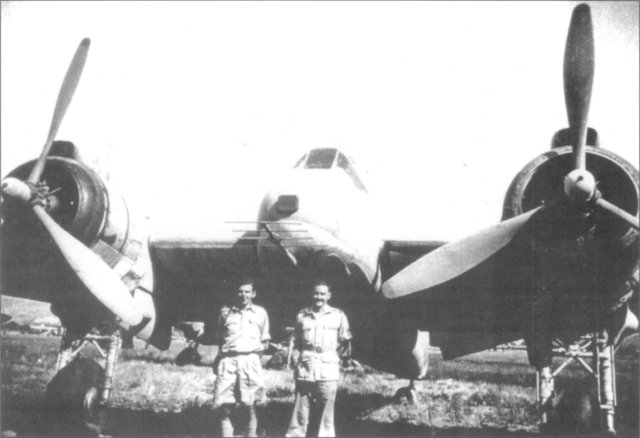
Two SSS technicians have just installed an ASV radar aerial
on the nose of a SAAF aircraft in the Western Desert.
The ten to fifteen man SSS teams attached to the SAAF had received specialised technical but not military training. As a security precaution, they had to guard their own workshops and stores and they kept very much to themselves, having little in common with the average air mechanic with whom they were quartered. The powers-that-be were concerned that some individuals might overhear and possibly, with careless talk, unconsciously pass on sensitive information. When the Allies invaded southern Europe, the military command asked for SSS technicians to accompany Gen Alexander's forces to supply various specialised services. Their duties included working on secret equipment with code names like 'Eureka', Gee', 'Loran', 'Mandrel' and 'Shoran'. The SSS also staffed active field radar stations in the campaign.
The SSS division of the SACS was a comparatively small specialist unit not linked to any other military force. By 1945 there were a mere 145 officers and 1 476 other ranks, including 535 women. Yet it is understood that their contribution to the war effort was most significant. However, most fellow South African servicemen and women in other units never knew anything about the SSS and because of the perhaps misguided continued secrecy after the war, few records survived. As a result of this, South Africa's own wide-ranging radar activities have largely been ignored by historians.
After the war, many of the SSS experts continued to make important contributions in science and technology. Basil Schonland became the first president of the CSIR (Council for Scientific and Industrial Research) in Pretoria and ultimately became the director of the Atomic Research Establishment at Harwell in England. He was knighted in 1961. Meanwhile, the SSS second-in-command, Major Boz Bozzoli, became the vice-chancellor of the University of the Witwatersrand in 1969. Major Frank Hewitt joined Schonland at the CSIR to start the Telecommunications Research Laboratory and in 1972 became a deputy president of the C5IR. Major Trevor Wadley's advanced electronic designs included a revolutionary Tellurometer using microwaves for measuring distances. Staff-sergeant Jules Feijer became one of the world's leading ionospheric physicists in North America.
Notes and acknowledgements
Geoffrey Mangin and Sheilah Lloyd were members of the SSS during the Second World War. Their address is now P0 Box 44553, Claremont, Cape Town. The assembled material is based on their own experiences, a few official documents, and by drawing heavily on Dr Peter Brain's book, South African Radar in World War II, published in 1993. The authors would like to thank various former members of the SSS for specific information supplied, especially Mr Tess Peter of Roosevelt Park and Dr Frank Hewitt, now of Vancouver. Some technical information was provided from research undertaken by Dr Brian Austin of Liverpool University's Department of Electrical Engineering and Electronics.
BIBLIOGRAPHY
Austin, B A, 'Radar in World War II, the South African Contribution'
in Engineering Science and Education Journal, Vol 1, No 3, June 1992, pp 121-13.
Brain, P, South African Radar in World War II, (SSS Radar Book, Claremont, 1993).
Hewitt, F J, 'South Africa's role in the development and use of radar in World War II',
Military History Journal, Vol 3 No 3, June 1975, pp 88-93.
Lloyd, S, '50 Years of Radar' in Elektron, SA Institute of Electrical Engineers, Sandton, 1990, pp 13-22.
Mangin, G, 'Outposts that scanned the sea and sky' (SSS Radar Contacts, Claremont, 1995).
Additional information
Some official and other 16mm motion pictures were made internally by the SSS in 1944 and 1945. UDES 221 illustrates the operations at the Amanzimtoti COL station and features women personnel involved in a simulated shipping emergency. The complete 66-minute Pal VHS video-cassette can be obtained from SSS Radar Books, P0 Box 44553, Claremont, 7735.
Return to Journal Index OR Society's Home page
South African Military History Society / scribe@samilitaryhistory.org